Posted: 4/11/18

What is the best battery? We spend so long in the hobby trying to answer that question ourselves along with seeking opinions on the subject from others. When talking batteries, most people go right to the battery used in the vehicle. But what about the forgotten batteries, the batteries that are essential to making it all happen. Those batteries are the radio batteries and their often just tossed into the radio and forgotten about until we hear lots of beeping to indicate its time for a battery charge or swap. But why not get more out of these batteries too? Wouldn't it be better if you got more time on the trails rather than spending time trying to figure out if you need new radio batteries? Or perhaps worse, your batteries go dead on the trail leaving you to haul your rig back home by hand.
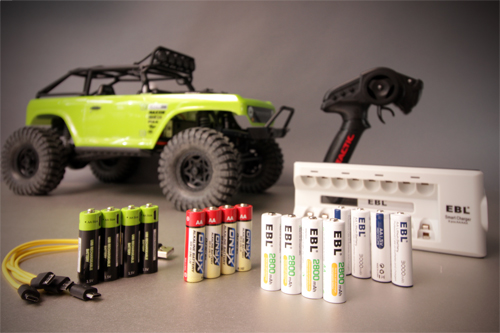
In this battery discussion, we're going to look at the popular available options for radio batteries, determining what is the best value and what will give you the best bang for your buck. After All, the longer you're on the trails, the more time you can spend taking photos and posting them to your social media pages with the hashtag #AxialAdventures.
Alkaline
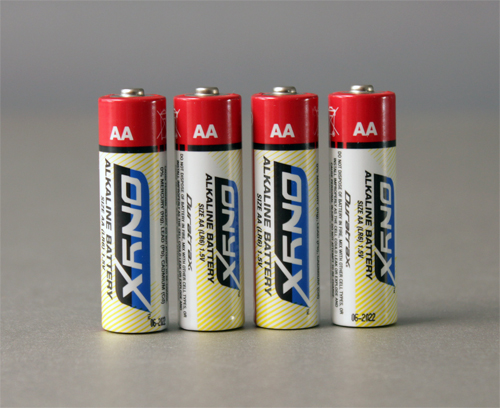
These are the most readily available batteries for your transmitter. Alkalines can be found at just about every store you walk into and hobby stores as well. Like any device you install them in, you pull them from the package, install them, use them and toss them in the battery bin at the nearest recycling center when you are done. These cells can last several few months depending on how often you use your RC machine.
EXAMPLE SHOWN:
Brand: Duratrax/ Onyx
Voltage: 1.5V
Average Capacity (at 50mA Drain): 1800-2600mAh
Rechargeable: No
Nickle Metal Hydrid
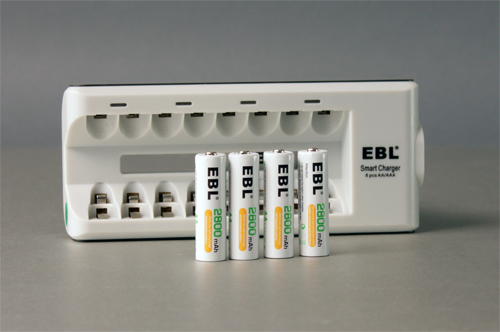
Nickel Metal Hydrid, now this may be a battery chemistry more familiar to many RC folk. This battery type is used to power many ready to run vehicles as it's main battery, just in a series of sub-C size cells which are larger than the cells above. But they are the same basic concept, an easy to use, easy and safe rechargeable cell that you can use over and over, sometimes up to several years. You can find these batteries in various capacities and the price may increase depending on the performance of the cell. You'll need a NiMh compatible charger to recharge these batteries and they are available in different capacities. These batteries can offer consistent operation, but eventually their performance can diminish and you may notice their capacity can lessen over time.
EXAMPLE SHOWN:
Brand: EBL
Voltage: 1.2V
Capacity: 2800mAh
Rechargeable: Yes
Lithium
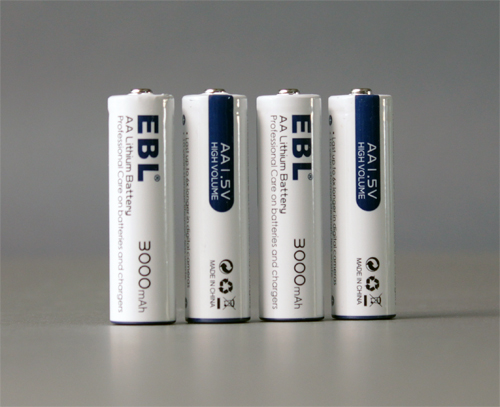
Lithium Polymer technology has made its way into an AA sized cell. LiPo cells are known for delivering consistent power through their use and they can be recharged. During their cycle life they will maintain consistency capacity output right up until they reach the end of their life cycle. Life cycle times can vary depending on the cell. Although they cost more than the others in this blog, they are the most powerful rechargeable cell. Depending on the brand you get, charging styles can vary. The cells above are charged by mini-usb style plugs with the included USB cord adapter.
EXAMPLE SHOWN:
Brand: Creative Standard Battery
Voltage: 1.5V
Capacity: 1250mAh
Rechargeable: Yes
Lithium Polymer
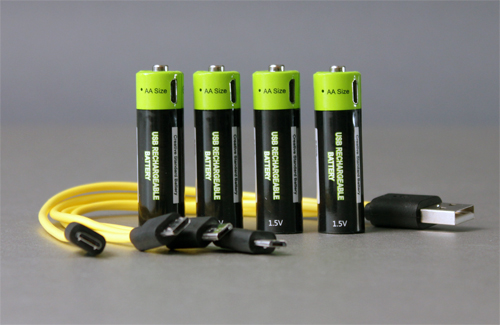
Lithium Polymer technology has made its way into an AA sized cell. LiPo cells are known for delivering consistent power through their use and of course they can be recharged. During their cycle life they will maintain consistency capacity output right up until they reach the end of their life cycle. Life cycle times can vary depending on the cell. Although they cost more than the others in this blog, they are a powerful rechargeable cell. Depending on the brand you get, charging styles can vary. The cells above are charged by mini-usb style plugs with the included USB cord adapter.
EXAMPLE SHOWN:
Brand: Creative Standard Battery
Voltage: 1.5V
Capacity: 1250mAh
Rechargeable: Yes
WHAT TO USE
Obviously the more economical choice over the long haul is to utilize a rechargeable battery. A great choice is the NiMh cell that offers consistent performance and long usage. The LiPo battery cost is slightly higher and depending on the cell can have a capacity near many NiMh offerings, but where the LiPo shines is if you are looking for a higher power output on the cell; 1.5 volts versus the NiMh 1.2 volts. Now if you're an install a battery and toss it (recycle it) when it's done type driver, the Lithium is a great choice, they're more expensive than the Alkaline battery, but performance and longevity are the winning factors here. And in the end, don't knock the Alkaline cells. These things can be snatched up at just about any store and they work, they work well. Just don't leave them in a radio if you store it for a long time. A leaky Alkaline cell is not pretty.